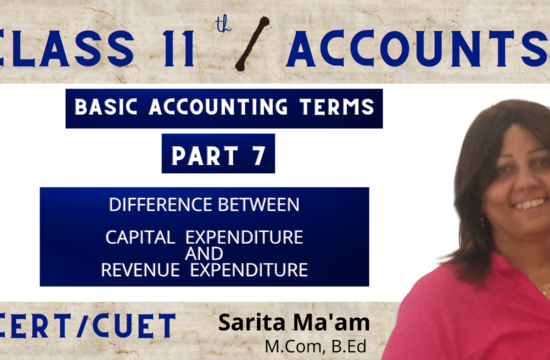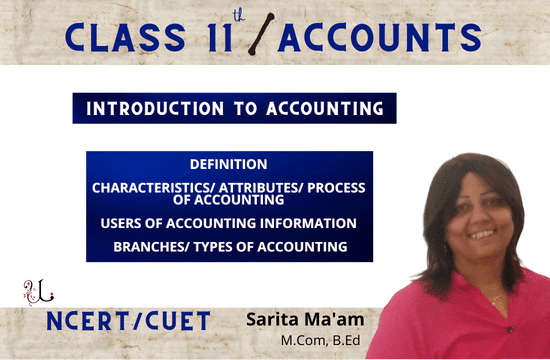Goods
Goods are the products in which the firm is dealing or producing for sale purposes.
Purchases
The term ‘Purchases’ is used for the purchase of goods.
In trading concerns, goods are purchased for resale
while in manufacturing concerns, raw materials are purchased and processed further into finished goods for resale purposes.
Example
For example, if a dealer of furniture purchases furniture for sale purposes, it is a goods. However if
Same dealer purchases furniture for sitting purpose in his business premises, it is not purchase of goods rather it is purchase of an asset.
Purchases may be for
- Cash purchases if the goods are purchased for cash, it is called ‘Cash Purchases’
- Credit Purchases if the goods are purchased on credit, it is called as ‘Credit Purchases.’
Accounting Treatment
Both Cash and credit purchases are debited to Trading Account.
Purchase Return
When purchased goods are returned to the supplier these are known as Purchase Return.
Such returns are also known as returns outwards
Accounting Treatment
Purchases return is deducted from the purchases to find out the net purchases to be debited to Trading Account
Sales
The term is used for sale of only those goods in which the firm is dealing i.e goods bought or produced or processed for resale purposes.
The term sales is never used for sale of asset, however, it includes revenue generated from services rendered to customers
Sales may be for
- Cash sales If the goods are sold for cash, it is called ‘Cash Sales
- Goods sold to customer on credit basis is called credit sales.
Accounting Treatment
Both Cash and Credit Sales is shown on the credit side of the Trading Account.
Sales Return
If the goods sold to customer are returned by the buyer, it is called Sales Return or Returns Inward.
Accounting Treatment
It is shown in the Trading A/c as deduction from sales
Trade Receivables:
Trade Receivables as defined in Schedule III of the Companies Act, 2013
Trade Receivables are the amounts receivable by the enterprise against goods sold and services rendered in the normal course of business.
It is the amount receivable for sale of goods and/or services rendered in the ordinary course of business. Stating differently, it is the amount due from the customers of the enterprise. Trade Receivables is a sum total of debtors and bills receivable.
Debtor: Debtor is a person or an entity who owes amount to the enterprise against credit sales of goods and/or services rendered. Goods when sold to a person on credit that person is called a Debtor because he owes that much amount to the enterprise.
Bill Receivable: Bill Receivable means a Bill of Exchange accepted by a debtor, the amount of which will be received on the specified date.
Trade Payables:
Trade Payables as defined in Schedule Ill of the Companies Act, 2013
Trade Payables are the amounts payable by the enterprise against goods purchased and services taken in the normal course of business.
It is the amount payable for purchase of goods and/or services taken in the ordinary course of business. Stating differently, it is the amount due to the seller of goods by the enterprise. Trade Payables is the sum total of creditors and bills payable.
Creditor: Creditor is a person or an enterprise to whom an enterprise owes amount against credit purchases of goods and/or services taken. For example, Mohan is a creditor of a firm when goods are purchased from him on credit.
Bill Payable: Bill Payable means a Bill of Exchange accepted by the person or enterprise, the amount of which will be payable on the specified date.
Stock/Inventory:
Stock (Inventory) is a tangible asset held by an enterprise for the purpose of sale in the ordinary course of business or for the purpose of using it in the production of goods meant for sale.
Stock (Inventory) may be: (i) Opening Stock (Inventory) or (ii) Closing Stock (Inventory).
- Opening Stock (Inventory) is the stock-in-hand in the beginning of the accounting year. In other words, it is stock-in-hand at the end of the previous accounting year.
- Closing Stock (Inventory) is the stock-in-hand at the end of the current accounting period.
Stock or Inventory may be of the following kinds:
- Stock or Inventory of Goods: Stock, Goods or Inventory in the case of a trading concern comprises stock (Inventory) of goods remaining unsold. In the case of manufacturing concern, it comprises processed goods manufactured for the purpose of sale. It is valued at cost or net realisable value, whichever is lower.
- Stock or Inventory of Raw Material: It comprises the stock of raw material used for manufacturing of goods lying unused. For example, stock of cloth to be used for stitching shirts. It is valued at cost or net realisable value, whichever is lower.
- Work-in-Progress: It is a stock that is in the process of being finished, i.e., they are partly finished goods. It is valued at an aggregate of cost of raw material used, cost of labour, other production cost, i.e., power, fuel, etc.
Accounting Treatment
Stock or Inventory is shown in the Balance Sheet as a Current Asset.
It is valued on the basis of “cost or net realisable value (market price), whichever is lower” principle
Voucher
A voucher is a written document prepared by the accountant providing the evidence of a business transaction. The evidence of a business transaction is called a source document viz., cash memo, purchase bill, sales bill, pay-in-slip, etc.
Vouchers are the printed forms of the firm and it specifies the accounts to be debited or credited. On the basis of vouchers, transactions are recorded for the first time in the books of original entry i.e. in journal or in the subsidiary books. As accounting entries are passed on the basis of vouchers so they are usually called as accounting vouchers and source documents of each transactions is attached with the vouchers. All the vouchers are numbered and signed by its maker.
Discount
Any type of reduction in the price of the goods by the business entity to its customers is called a discount. Discount is of two types, namely‑
(i) Trade Discount
(ii) Cash Discount
- Trade Discount—When a dealer of goods is allowed reduction in the price of goods at a fixed percentage on the list price or catalogue price by the another dealer while making sales, it is called as trade discount.
The objective behind giving reduction in the list price is that the ultimate consumer of the goods gets the product at the list price. It is generally offered by the manufactures of goods to wholesalers and wholesalers to retailers. This reduction in the list price is deducted from the sale price directly so the entry is passed for the net amount of sales price.
Hence, no entry for trade discount is passed in the books of accounts.
- Cash Discount—When the debtors are allowed some discount (reduction) in the amount due to induce them to make prompt payment or to make payment within the specified time, it is called as cash discount. It is always recorded in the books of accounts. It is of two types, namely—
(a) Discount allowed
(b) Discount received
(a) Discount allowed – If cash discount is allowed to debtors to induce them to make prompt payment, it is called as discount allowed. It is a loss so it is treated as an expense and debited to Profit & Loss Account.
(b) Discount received – If the cash discount is received by the creditors for make prompt payment of goods bought, it is called discount received. Being an income it is credited to Profit and Loss Account.
Exercise
Q1. …………….. Discount is never recorded in the books of accounts.
Trade Discount
Q2. When debtors are given some discount to induce them to make prompt payment is called ………………… discount
Cash
Q3. A person to whom goods are sold on credit is called a ……..
Debtor
Q4. A person from whom goods are bought on credit is called ……………….
Creditor
Q5. A bill of exchange accepted by the buyer of goods is called ………………….
Bills payable
Q6. Reduction in the list price of goods at a fixed rate is called …………………… discount
Trade Discount
HOME WORK
Determine, if the following are Assets, Liabilities, Capital, and Revenue from Operations, Revenues, Expenses or none:
- Machinery, (b) Purchases, (c) Stock, (d) Creditors, (e) Capital, (f) Salary paid to a clerk, (g) Sales, (h) Furniture, (i) Interest received and (j) Rent paid.
SOL
[(a) Asset;
(b) Expense;
(c) Asset;
(d) Liability;
(e) Capital;
(f) Expense;
(h) Asset;
(t) Revenue;
(j) Expense. PART 3

Sarita Chugh M.Com, B.Edan is Accounts and Economics teacher having more than 30+ years of experience. She is Edupreneur and founded Unique Learning Academy in 2004. She believes that every child has the right to affordable education.










